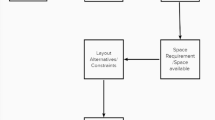Abstract
In this paper, the effects of various dispatching rules on the operation and performance of cellular manufacturing systems (CMS) are evaluated. When the study of a CMS considers the automated material handling, it is crucial to reduce the gridlock probability (i.e., the probability of an unsuccessful load transfer attempt occurring in the interface point between the intercell and intracell handling system). Preventing an unsuccessful load transfer is critical for the operation of the entire system as a blockage between the automated guided vehicle (AGV) and the overloaded cell results in a total system shutdown. The gridlock probability is influenced by the dispatching rule used to schedule the load transfers in the system. Therefore, in order to reduce this probability it is necessary to use a dispatching rule that will decrease the number of waiting loads in the transfer spurs. The main objective of the paper presented herein is to identify a dispatching rule that maintains the system operational at all times. A group of dispatching rules, including the first come first served (FCFS), shortest imminent operation (SI), longest imminent operation (LI), most remaining operations (MRO), shortest processing time (SPT), shortest remaining process time (SR), and a newly developed rule proposed by the authors, loads with the minimum number of processing first (MNP), are tested and evaluated with respect to whether the capacity of the transfer spurs of the cells is exceeded. This paper presents a simulation model of a cellular manufacturing system, which is used to further explore the effects of the dispatching rules on the system performance. The results show superior performance of the newly proposed MNP rule.
Similar content being viewed by others
References
Egbelu PJ (1992) A Framework for integrating product design, process plan, and materials handling system design decisions. In: Materials Handling Research Colloquium, Milwaukee, WI, USA, June 1992
Malmborg JC (1994) A heuristic model for simultaneous storage space allocation and block layout planning. Int J Prod Res 32(2):517–530
Kizil M, Özbayrak M (1995) Loop layout and materials handling Systems: Simulated annealing approach. In: Proceedings of the national operations research and industrial engineering conference, Middle East Technical University, Ankara, Turkey
Lee J, Tangjarvhij M, Zhu Z (1996) Load selection of automated guided vehicles in FMS. Int J Prod Res 34(12):3383–3400
Waikar AM, Sarker BS, Lal AM (1995) A comparative study of some priority dispatching rules under different shop loads. Prod Plann Control 6(4):301–310
Chang YL, Sueyoshi T, Sullivan RS (1996) Ranking dispatching rules by data envelopment analysis in a job shop environment. Trans IIE 28(8):631–642
Pierreval H, Mebarki N (1997) Dynamic selection of dispatching rules for manufacturing system scheduling. Int J Prod Res 35(6):1575–1591
Naumann A, Gu P (1997) Real-time part dispatching within manufacturing cells using fuzzy logic. Prod Plann Control 8(7):662–669
Hwang K, Sang HIM (1998) A new automated guided vehicle dispatching algorithm based on a bidding concept. J Manuf Syst 17(2):137–143
Smith J, Peters BA, Srinivasan A (1999) The job-shop scheduling considering materials handling. Int J Prod Res 37(7):1541–1560
Kizil M (2000) The design and evaluation of cellular manufacturing systems with routing, dispatching, and storage space allocation considerations. In: Working paper, Rensselaer Polytechnic Institute, Troy, New York
Holthaus O, Rajendran C (2000) Efficient job shop dispatching rules: further developments. Prod Plann Control 11(2):171–178
Rajendran C, Holthaus O (1999) A comparative study of dispatching rules in dynamic flow shops and job shops. Eur J Oper Res 116(1):156–170
Bragli M, Petroni A (1999) Data envelopment analysis for dispatching rule selection. Prod Plann Control 10(5):454–461
Gupta JND, Luong LHS, Nguyen VH (1999) Part dispatching and machine loading in flexible manufacturing systems using central queues. Int J Prod Res 37(6):1427–1435
Jayamohan MS, Rajendran C (2000) New dispatching rules for shop scheduling: a step forward. Int J Prod Res 38(3):563–586
Lin JT, Wang F-K, Yen P-Y (2001) Simulation analysis of dispatching rules an automated interbay material handling system in wafer fabrication. Int J Prod Res 39(6):1221–1238
Ferrell W Jr, Sale J, Sams J, Yellamraju M (2000) Evaluating simple scheduling rules in a mixed shop environment. Comput Ind Eng 38:39–66
Blackstone JH, Phillips DT, Hogg GL (1982) A state-of-the-art survey of dispatching rules for manufacturing job shop operations. Int J Prod Res 20(1):27–45
Feng-Chang RC (1996) A study of due-date assignment rules with constrained tightness in a dynamic job shop. Comput Ind Eng 31(1–2):205–208
Aytug H, Barua A, Lawley M, Uzsoy R (2003) Observations on the interactions among deadlock avoidance policies and dispatching rules in automated manufacturing systems. Int J Prod Res 41(1):81–95
Holthaus O, Rajendran C (2002) A study on the performance of scheduling rules in buffer-constrained dynamic flowshops. Int J Prod Res 40(13):3041–3052
Chan FTS, Chan HK, Lau HCW, Ip RWL (2003) Analysis of dynamic dispatching rules for a flexible manufacturing system. J Mater Process Technol 138(1):325–331
Pedgen DC, Shannon RE, Sadowski RP (1990) Introduction to Simulation Using SIMAN. McGraw-Hill, New York
Kizil M, Ozbayrak M (2004) A tradeoff analysis between process plan selection and cell formation in cellular manufacturing. Int J Adv Manuf Technol (23):501–506
Author information
Authors and Affiliations
Rights and permissions
About this article
Cite this article
Kızıl, M., Özbayrak, M. & Papadopoulou, T.C. Evaluation of dispatching rules for cellular manufacturing. Int J Adv Manuf Technol 28, 985–992 (2006). https://doi.org/10.1007/s00170-004-2439-2
Received:
Accepted:
Issue Date:
DOI: https://doi.org/10.1007/s00170-004-2439-2




